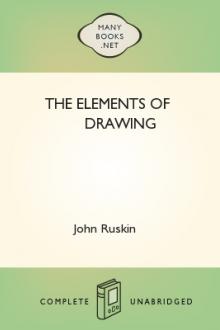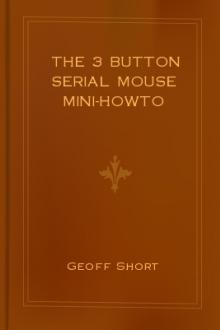The Elements of Drawing by John Ruskin (smart books to read .txt) 📕

- Author: John Ruskin
- Performer: -
Book online «The Elements of Drawing by John Ruskin (smart books to read .txt) 📕». Author John Ruskin
Note 2, p. 59.—"Dark lines turned to the light."
248. It ought to have been farther observed, that the inclosure of the light by future shadow is by no means the only reason for the dark lines which great masters often thus introduce. It constantly happens that a local color will show its own darkness most on the light side, by projecting into and against masses of light in that direction; and then the painter will indicate this future force of the mass by his dark touch. Both the monk's head in Fig. 11 and dog in Fig. 20 are dark towards the light for this reason.
Note 3, p. 98.—"Softness of reflections."
249. I have not quite insisted enough on the extreme care which is necessary in giving the tender evanescence of the edges of the reflections, when the water is in the least agitated; nor on the decision with which you may reverse the object, when the water is quite calm. Most drawing of reflections is at once confused and hard; but Nature's is at once intelligible and tender. Generally, at the edge of the water, you ought not to see where reality ceases and reflection begins; as the image loses itself you ought to keep all its subtle and varied veracities, with the most exquisite softening of its edge. Practice as much as you can from the reflections of ships in calm water, following out all the reversed rigging, and taking, if anything, more pains with the reflection than with the ship.
Note 4, p. 100.—"Where the reflection is darkest, you will
see through the water best."
250. For this reason it often happens that if the water be shallow, and you are looking steeply down into it, the reflection of objects on the bank will consist simply of pieces of the bottom seen clearly through the water, and relieved by flashes of light, which are the reflection of the sky. Thus you may have to draw the reflected dark shape of a bush: but, inside of that shape, you must not draw the leaves of the bush, but the stones under the water; and, outside of this dark reflection, the blue or white of the sky, with no stones visible.
Note 5, p. 101.—"Approach streams with reverence."
251. I have hardly said anything about waves of torrents or waterfalls, as I do not consider them subjects for beginners to practice upon; but, as many of our younger artists are almost breaking their hearts over them, it may be well to state at once that it is physically impossible to draw a running torrent quite rightly, the luster of its currents and whiteness of its foam being dependent on intensities of light which art has not at its command. This also is to be observed, that most young painters make their defeat certain by attempting to draw running water, which is a lustrous object in rapid motion, without ever trying their strength on a lustrous object standing still. Let them break a coarse green-glass bottle into a great many bits, and try to paint those, with all their undulations and edges of fracture, as they lie still on the table; if they cannot, of course they need not try the rushing crystal and foaming fracture of the stream. If they can manage the glass bottle, let them next buy a fragment or two of yellow fire-opal; it is quite a common and cheap mineral, and presents, as closely as anything can, the milky bloom and color of a torrent wave: and if they can conquer the opal, they may at last have some chance with the stream, as far as the stream is in any wise possible. But, as I have just said, the bright parts of it are not possible, and ought, as much as may be, to be avoided in choosing subjects. A great deal more may, however, be done than any artist has done yet, in painting the gradual disappearance and lovely coloring of stones seen through clear and calm water.
Students living in towns may make great progress in rock-drawing by frequently and faithfully drawing broken edges of common roofing slates, of their real size.
Note 6, p. 125.—"Nature's economy of color."
252. I heard it wisely objected to this statement, the other day, by a young lady, that it was not through economy that Nature did not color deep down in the flower bells, but because "she had not light enough there to see to paint with." This may be true; but it is certainly not for want of light that, when she is laying the dark spots on a foxglove, she will not use any more purple than she has got already on the bell, but takes out the color all round the spot, and concentrates it in the middle.
Note 7, p. 138.—"The law of repetition."
253. The reader may perhaps recollect a very beautiful picture of Vandyck's in the Manchester Exhibition, representing three children in court dresses of rich black and red. The law in question was amusingly illustrated, in the lower corner of that picture, by the introduction of two crows, in a similar color of court dress, having jet black feathers and bright red beaks.
254. Since the first edition of this work was published, I have ascertained that there are two series of engravings from the Bible drawings mentioned in the list at p. 50. One of these is inferior to the other, and in many respects false to the drawing; the "Jericho," for instance, in the false series, has common bushes instead of palm trees in the middle distance. The original plates may be had at almost any respectable printseller's; and ordinary impressions, whether of these or any other plates mentioned in the list at p. 50, will be quite as useful as proofs: but, in buying Liber Studiorum, it is always well to get the best impressions that can be had, and if possible impressions of the original plates, published by Turner. In case these are not to be had, the copies which are in course of publication by Mr. Lupton (4 Keppel Street, Russell Square) are good and serviceable; but no others are of any use.—[Note of 1857.]
I have placed in the hands of Mr. Ward (Working Men's College) some photographs from the etchings made by Turner for the Liber; the original etchings being now unobtainable, except by fortunate accident. I have selected the subjects carefully from my own collection of the etchings; and though some of the more subtle qualities of line are lost in the photographs, the student will find these proofs the best lessons in pen-drawing accessible to him.—[Note of 1859]
II.THINGS TO BE STUDIED.
255. The worst danger by far, to which a solitary student is exposed, is that of liking things that he should not. It is not so much his difficulties, as his tastes, which he must set himself to conquer: and although, under the guidance of a master, many works of art may be made instructive, which are only of partial excellence (the good and bad of them being duly distinguished), his safeguard, as long as he studies alone, will be in allowing himself to possess only things, in their way, so free from faults, that nothing he copies in them can seriously mislead him, and to contemplate only those works of art which he knows to be either perfect or noble in their errors. I will therefore set down, in clear order, the names of the masters whom you may safely admire, and a few of the books which you may safely possess. In these days of cheap illustration, the danger is always rather of your possessing too much than too little. It may admit of some question, how far the looking at bad art may set off and illustrate the characters of the good; but, on the whole, I believe it is best to live always on quite wholesome food, and that our enjoyment of it will never be made more acute by feeding on ashes; though it may be well sometimes to taste the ashes, in order to know the bitterness of them. Of course the works of the great masters can only be serviceable to the student after he has made considerable progress himself. It only wastes the time and dulls the feelings of young persons, to drag them through picture galleries; at least, unless they themselves wish to look at particular pictures. Generally, young people only care to enter a picture gallery when there is a chance of getting leave to run a race to the other end of it; and they had better do that in the garden below. If, however, they have any real enjoyment of pictures, and want to look at this one or that, the principal point is never to disturb them in looking at what interests them, and never to make them look at what does not. Nothing is of the least use to young people (nor, by the way, of much use to old ones), but what interests them; and therefore, though it is of great importance to put nothing but good art into their possession, yet, when they are passing through great houses or galleries, they should be allowed to look precisely at what pleases them: if it is not useful to them as art, it will be in some other way; and the healthiest way in which art can interest them is when they look at it, not as art, but because it represents something they like in Nature. If a boy has had his heart filled by the life of some great man, and goes up thirstily to a Vandyck portrait of him, to see what he was like, that is the wholesomest way in which he can begin the study of portraiture; if he loves mountains, and dwells on a Turner drawing because he sees in it a likeness to a Yorkshire scar or an Alpine pass, that is the wholesomest way in which he can begin the study of landscape; and if a girl's mind is filled with dreams of angels and saints, and she pauses before an Angelico because she thinks it must surely be like heaven, that is the right way for her to begin the study of religious art.
256. When, however, the student has made some definite progress, and every picture becomes really a guide to him, false or true, in his own work, it is of great importance that he should never look, with even partial admiration,





Comments (0)